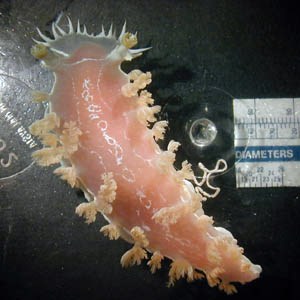Tritonia diomedea - big puzzle
January 17, 2003
From: Russell Wyeth


Hello,
I'm a graduate student working at the University of Washington. We do a lot of field work with the giant orange nudibranch, Tritonia diomedea. We've been struggling with a big puzzle for some time now, and I thought I'd ask around to see if anyone had any insight or observations to help us. Basically, the problem is that we never see small animals. We dive a lot on sea pen beds, and there are lots of larger animals ... say 7cm and longer. Not surprising since Tritonia eats sea pens. But smaller animals are incredibly rare. So rare, that they really must be somewhere else -- its not that they are small and harder to see. Has anyone ever seen significant densities of smaller Tritonia diomedea? Anyone observed them feeding on anything but sea pens or sea whips? I'd suspect, from their congeners feeding habitats, that perhaps they start out feeding on a deeper soft coral, but I know of no such observations.
Another strange observation is that although Tritonia only eats sea pens and sea whips, there are more sea pen and sea whip beds without Tritonia than beds with the slugs (that we've observed so far). As far as we can tell, the habitats are the same -- same substratum, roughly the same current flow speeds, same densities of sea pens, yet there are no slugs in 3 or 4 such beds, for every one that has slugs. And its not just an that there are 'blooms' of Tritonia -- the same sea pen beds continue to have slugs year after year.
Does anyone have any thoughts on what might be unusual factors regulating population densities?
The upper picture is of T. diomedea with sea pens, and the lower photo is of the closely related species Tritonia festiva which could be mistaken for smaller Tritonia diomedea, but which has broader habitat and food tastes.
Thanks in advance,
Russell
rwyeth@u.washington.edu
Dear Russell,
This is an interesting question. The obvious comment, which you address in your message, is that the juveniles are hiding somewhere. Is it possible they are living in the sand and only feeding on 'subterranean' or rather 'subsand' parts of the sea pens? Secondly does T. diomedea have an annual life cycle, if so then it is unlikely you would see big and very small animals together.
James Murray describes some aspects of the biology of this species on Mike Miller's Slug Site [http://slugsite.us/bow/nudiwk76.html] which I summarise below:
=========
"It feeds on pennatulacean cnidarians- Ptilosarcus gurneyi, Virgularia, and Stylatula elongata in Washington and British Columbian waters, and Acanthoptilum in Californian waters as deep as 200 m. .... will also feed on the Californian sea pansy Renilla koellikeri in the laboratory although it is unknown if they do so in nature. It appears that in many cases a geographically isolated group of Tritonia will eat only one prey species, and this prey species varies between groups. T. diomedea lives among beds of these soft corals on flat or gently sloping soft bottoms of sand or silt.
T. diomedea found among Virgularia tend to be smaller (0.5-20 cm) than those found among Ptilosarcus (8-30 cm). To my knowledge, no Tritonia diomedea under 5 cm has ever been found in a Ptilosarcus bed, although it metamorphoses from a veliger larva into a slug ~1 mm long. Whether smaller slugs are difficult to locate, or are migrating from elsewhere after growing is unknown. Those found among Ptilosarcus tend to be orange (like Ptilosarcus), with distinct tubercles on the dorsum, while those found among Virgularia tend to be redder in hue, from brick red to pale pink, and have a smoother dorsum (MacFarland 1966 for color illustration). It is unknown whether these two forms are genetically distinct, but the two forms will mate and do produce motile veligers." ... James Murray -University of Central Arkansas
==========
From this it seems that James Murray has also found it impossible to find juveniles on Ptilosarcus although they are found on Virgularia. Certainly looks like an interesting problem for someone to study
Best wishes,
Bill Rudman
Related messages
-
Re: Tritonia diomedea from Puget Sound
From: Paul Katz, February 19, 2008 -
Re: Tritonia diomedea from southern California
From: Sheri Bauer, November 6, 2007 -
Tritonia diomedea from Puget Sound
From: Jan Kocian, March 17, 2006 -
Tritonia diomedea from California
From: Steve Johnston, July 22, 2004 -
Re: Tritonia diomedea - big puzzle
From: Cynthia Trowbridge, January 18, 2003 -
Tritonia diomedea from Monterey, CA
From: Clinton Bauder, March 6, 2002 -
Re: Food source for Tritonia diomedea
From: Kerry Clark, June 25, 1998 -
Food source for Tritonia diomedea
From: Paul Katz, June 5, 1998
